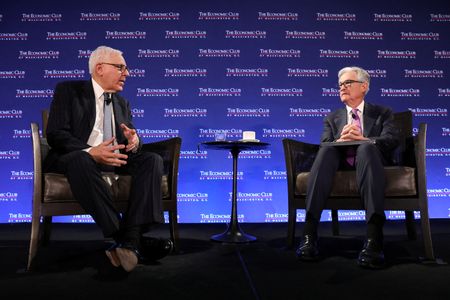By Howard Schneider and Andrea Shalal
WASHINGTON (Reuters) – After vouching last week that a “gratifying” drop in inflation was underway, Federal Reserve Chair Jerome Powell will face questions on Tuesday about whether a blowout January jobs report has shaken his confidence the decline can continue without harsher steps by the U.S. central bank to slow the economy.
Fed officials, including Powell, are typically reluctant to put weight on single data points, and the Labor Department report on Friday showing 571,000 jobs were added in January may be seen as particularly “noisy” given annual data revisions and seasonal adjustments. Indeed, on an unadjusted basis, employers cut jobs last month as they do every January but by a much smaller amount than usual, resulting in the largest seasonally adjusted increase in six months.
But, with the unemployment rate hitting its lowest level since 1969 at 3.4%, January’s numbers were still far out of line with the looser labor market the Fed has expected and feels will be needed to ensure that wage growth also slows and inflation continues to fall.
Investors skeptical of the Fed’s interest rate hike plans have now matched officials’ own projections in seeing the benchmark overnight interest rate increased by another half of a percentage point this year, to a range of 5.00% to 5.25%, while some economists pushed even further in suggesting the January jobs report showed the economy was still too hot for the Fed’s comfort and required even tighter monetary policy.
Graphic: Job gains remain strong- https://www.reuters.com/graphics/USA-FED/POWELL/xmvjkrbdgpr/chart.png
“It is increasingly difficult to make the case that the Fed has slowed the economy substantially enough to return inflation” to the 2% target, Citi economists wrote on Monday, seeing a “hawkish risk” in the remarks that Powell will make to the Economic Club of Washington starting at 12:40 EST (1740 GMT).
The Fed last week increased its policy rate by a quarter of a percentage point to the 4.50%-4.75% range, returning to a more conventional rate-hike increment after nearly a year of three-quarters-of-a-percentage-point and half-percentage-point hikes.
Powell said that in slowing down to quarter-percentage-point steps the Fed was trying to “make a fine judgment” about how high rates needed to go without stepping too far and tightening credit conditions so much that it increases the risk of, or even causes, a jobs-destroying recession.
He noted that a process of “disinflation” seemed to be taking hold so far without throwing employment off course – a hoped-for outcome if it can continue but one that might prove unsustainable if job growth doesn’t slow.
Graphic: Rates and inflation Rates and inflation-https://www.reuters.com/graphics/USA-FED/INFLATION/gkvlgnaywpb/chart.png
HARDER CALLS AHEAD
By the Fed’s preferred measure, prices as of December were still increasing at a 5% annual rate, but the pace has been slowing and is expected to continue doing so. The consumer price index report for January is due to be released next week, with economists projecting another decline in the annual pace though perhaps a smaller one than has been the case in recent months.
David Kamin, former deputy director of the Biden administration’s National Economic Council and now a law professor at New York University, said after a wrenching move in interest rates last year the Fed’s toughest choices may lie ahead. Policymakers now must balance what may be slowing progress towards their 2% inflation target against risks to the economy if they move rates even higher than expected, he added.
The full impact of the Fed’s already-anticipated rate increases still has not been felt on the economy, meaning the current strength in the job market and elsewhere may in fact begin to wane, Kamin said. At the same time, the easy progress in lowering inflation may have been realized, with goods prices moderating as supply chains improve but services inflation showing itself to be more stubborn.
“The Fed will have to figure out a path through, taking into account on one hand that some share of the effects have not necessarily been felt in the economy, and on the other that some of the factors that brought inflation down may not repeat,” Kamin said. “The Fed has a series of harder calls to make.”
Graphic: The jobs hole facing Biden and the Fed – https://www.reuters.com/graphics/USA-ECONOMY/JOBS/jbyprzlrqpe/chart.png
Powell’s tone on Tuesday will be telling, whether he interprets the January numbers as evidence Fed policy is not yet “restrictive” enough, or as a possible step towards a pre-pandemic state of affairs he has lauded.
In 2019, the unemployment rate stood at 3.5% alongside inflation that was around the Fed’s target and modest wage growth, conditions Powell at the start of the health crisis said he hoped the economy could regain. Though job growth has remained remarkably strong, the economy is by many estimates still perhaps a million or more positions short of what would have been reached given job growth trends before the onset of COVID-19, suggesting more room for growth.
The issue for Powell and other Fed policymakers is whether the economy begins to look so strong – whether in terms of job growth, an expected rebound in manufacturing, or from financial markets that recently have been bidding home mortgage and other key market interest rates lower – it undermines their faith that inflation will continue slowing.
“We should be open to the idea of an acceleration of activity in the first half of the year,” Tim Duy, chief U.S. economist at SGH Macro Advisors, wrote. “The data overran the Fed last week, and Powell and his colleagues are falling behind the curve again. It’s time to start looking for a higher terminal rate.”
(This story has been refiled to say “jibe,” not jive, in the headline)
(Reporting by Howard Schneider; Additional reporting by Andrea Shalal; Editing by Dan Burns and Paul Simao)

